Which Animal Was An Iconographic Symbol Of Eternal Life In Heaven?
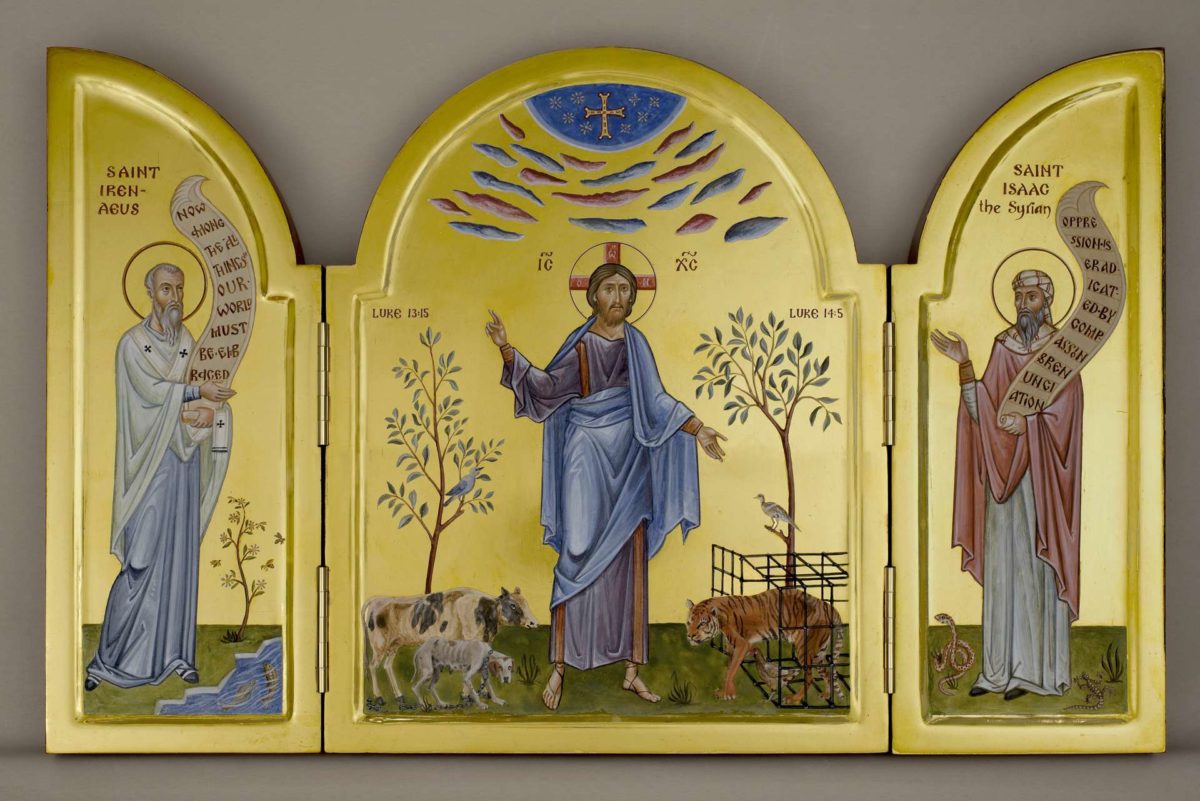
Sometimes I am commissioned to paint an icon of a saint for whom zippo yet exists, or at least no satisfactory icon. This is usually a pre-schism Western saint. But more rarely, the subject is a new theme, a new emphasis or combination. This was the example when Dr Christine Nellist approached me to create an icon that embodied some of the Orthodox Church's teaching about our relationship with animals. The icon was to exist used as flagship for her newly founded organisation "Pan-Orthodox Concern for Animals" (http://www.panorthodoxconcernforanimals.org/) and to illustrate her pending book on the subject area. This article tells the story of its genesis and explains its design.
The brief was for the icon to affirm the need to love all creation, but especially to treat our fellow animals with the respect and kindness due to all God'southward creatures. It had to evidence that Christ came not just to redeem humankind from the fall, simply also, through our repentance, to evangelize the creature kingdom from our oppressive and cruel treatment of them. Every bit Saint Paul wrote to the Romans:
For the creation waits with eager longing for the revealing of the sons of God . . . considering the creation itself will exist prepare gratis from its bondage to disuse and obtain the glorious liberty of the children of God'. (Romans eight: xix, 21)
The icon you see illustrated is what we eventually created. It required both theological research and research into by iconography, and then I would like outline how these two came together.
The Bible and animals: the kickoff, eye and cease
The Bible narrative begins and ends with lots of animals. The creation business relationship in Genesis teems with them. I whole 24-hour interval is defended to the creation of only the water creatures and the birds, and another to the creation of country animals and humankind. God liked what He fabricated, declared information technology good, and blessed the creatures to multiply and make full the earth.
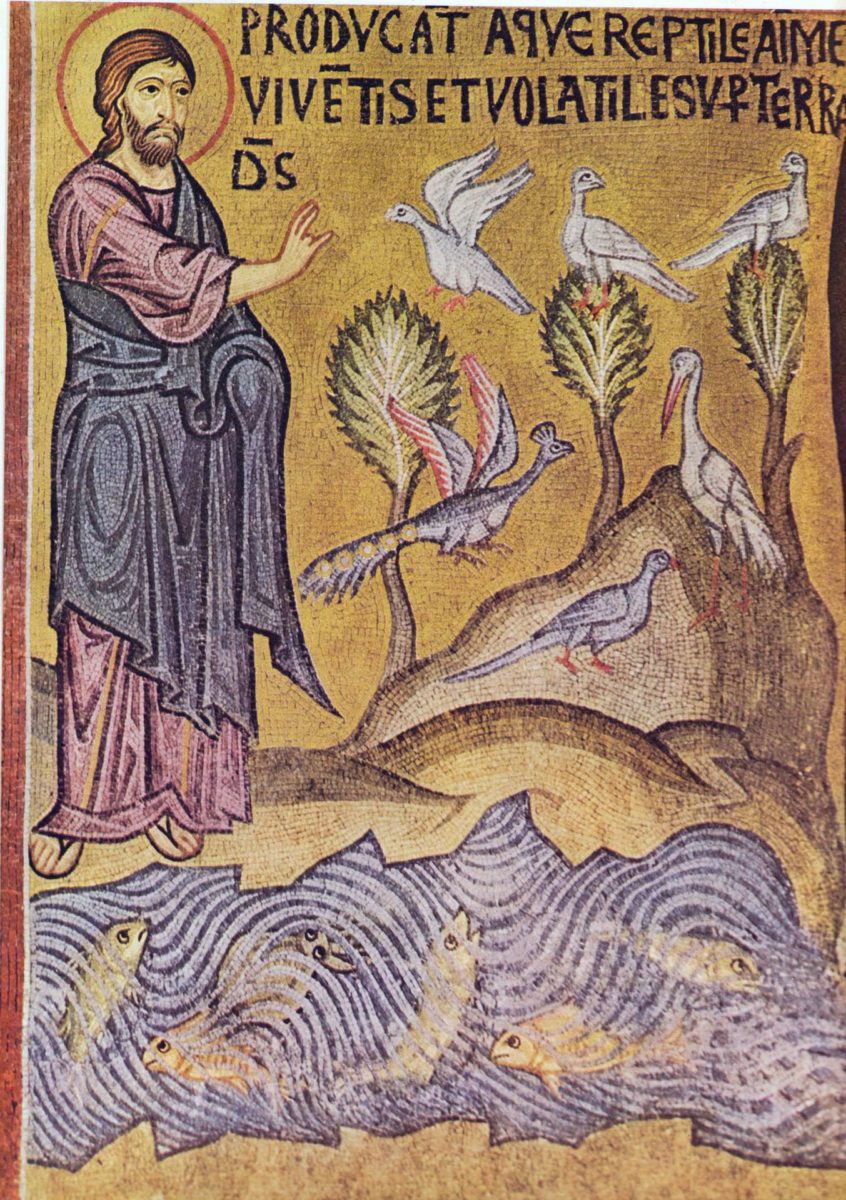
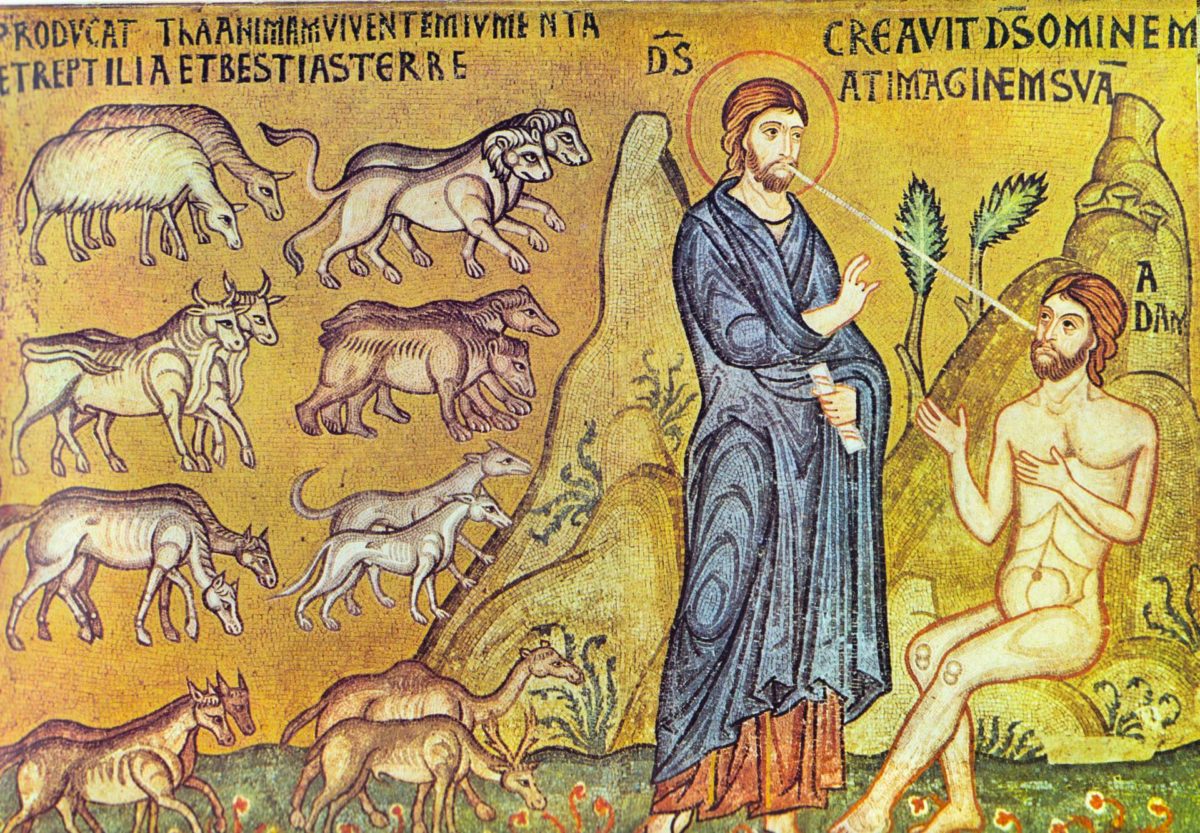
The last book of the Scriptures – Revelation – ends with a description of the New Jerusalem, the holy mountain coming down out of heaven from God. Although the Evangelist John himself does not include animals in his description of this New Jerusalem, the prophet Isaiah certainly does. In only 3 verses Isaiah names 13 dissimilar animate being species to be found on the Holy Mountain:
6 The wolf shall dwell with the lamb,
and the leopard shall lie downwardly with the kid,
and the dogie and the lion and the fatling together,
and a little child shall pb them.
vii The moo-cow and the comport shall feed;
their young shall lie down together;
and the panthera leo shall consume straw like the ox.
viii The sucking child shall play over the hole of the asp,
and the weaned child shall put his hand on the adder'southward den.
nine They shall not hurt or destroy
in all my holy mountain;
for the earth shall exist full of the knowledge of the Lord
as the waters cover the sea. (Isaiah 11:six-ix)
Between this commencement and this terminate the Bible of class refers to animals many other times. Merely as a consequence of the autumn our relationship with the animal kingdom is far from what is described of Eden and the New Jerusalem. Into the midst of this man-made mess comes Christ. The turning point of history is the incarnation of God in Christ. The focus of this has naturally been the redemption of the human race. Just because nosotros live in this world and nosotros are supposed to exist earth'south carers, this redemption implicitly involves our human relationship with animals.
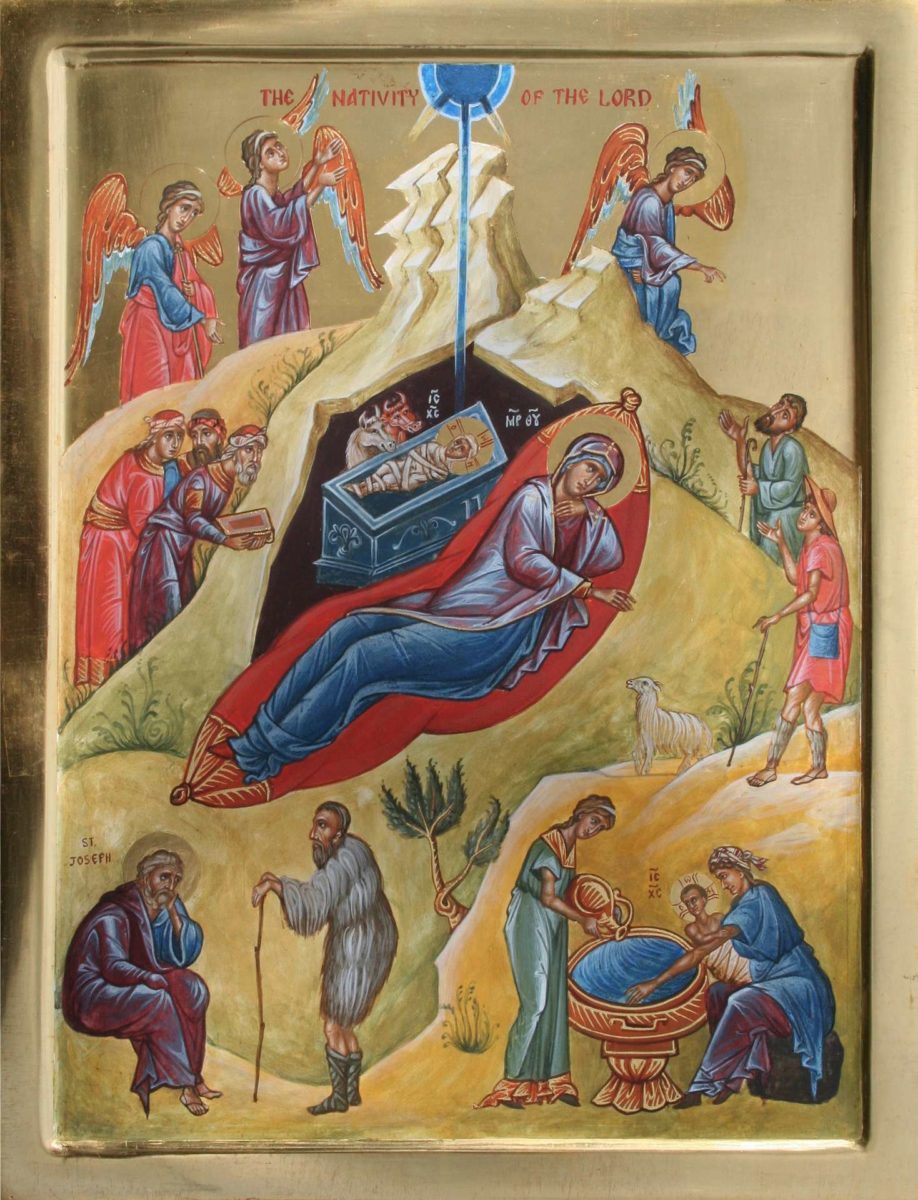
Unsurprisingly, the icon of Christ's Birth depicts animals: an ox and an donkey in the manger, and sheep with their shepherds. These creatures play an important part in the icon's delineation of the divine drama. Of all the created beings in the icon, it is the ox and the ass that sit closest to the Christ Kid. These 2 animals are included non just because Christ was born in a manger, but also to illustrate Isaiah's prophecy:
The ox knows its owner,
And the donkey its main's crib;
but Israel does not know,
my people do non empathize. (Isaiah 1:iii)
Both the icon and the Orthodox liturgical texts for the Nativity propose that at the incarnation God began to restore paradise, and thus to heal the broken relationship between God, man and animals:
Bethlehem has opened Eden; come and let u.s. run across. Nosotros take found joy in secret: come, let us take possession of the paradise that is within the cave. There the unwatered root has appeared. (Ikos, Canon of Matins)
Some commentators say that the ox and the donkey stand shut to the Christ Child not only because they recognize their Creator, merely besides because they are warming the Christ Child with their breath! According to the cosmos account in Genesis, animals are helpmates for u.s.a., and here they are being simply that.
It is surely pregnant that of all the Jewish people God chose shepherds to receive the revelation and to greet the new-born Kid. A shepherd cares for his sheep, knows them all by name, and will even gamble his life to protect them. It is perhaps this nurturing human relationship with God'due south lesser creatures that prepared the shepherds to receive the phenomenal news of Christ'due south nascency. God even invited them straight through angels, and not through a dumb and distant star as He did for the worldly wise Magi.
So, in i way or another, our destiny as humans seems linked to animals. God created u.s.a. on the aforementioned twenty-four hours that He created the animals, so you could say that we are neighbours, and indeed, that we are related.
The icon's design
In the Orthodox Church, icons are images of people or sacred events to be venerated. Icons are, in the fullest sense of the word, personal, and not just a cerebral analogy of an idea or a organisation. And so Christine and I didn't want the triptych to be only a didactic tool. It had to be an icon of a person or sacred event that could be venerated in church. September anest provided a liturgical celebration that is directly concerned with creation. This 24-hour interval was established by Patriarch Dimitrios I as an official commemoration of prayer for all creation. Then this fix the liturgical scene for such an icon. It could exist legitimately used for veneration in church on that day.
In that location was likewise the feast of the Resurrection. Christine had originally suggested that the triptych could be a variation of the Resurrection icon, with Christ delivering not just people from the bonds of Hades but also animals. But this was problematic. It would have raised the thorny, and ultimately unanswerable, question of whether or not animals had eternal souls. It would have based the instance for non-cruelty to animals on the respond, and therefore undermining it if the viewer believed animals to exist soulless.
The argument had to be more secure: animals are to be cared for but because God created them, soul or no soul. Full stop.
But nosotros nonetheless wanted to prove Christ actively liberating animals from cruelty. The Resurrection icon remained an obvious starting point, but the design had to be more subtle than merely calculation animals to the nighttime completeness of Hades.
So the challenge remained how to express Christ'due south redemption of animals from cruelty and oppression without the icon merely illustrating an idea – albeit a very important one. I decided to prepare our human relationship with animals in the context of God's intention for humankind by signifying the three principal "epochs" described above: Paradise, the incarnation, and the New Jerusalem. Why such a grand telescopic?
Paradise and the Incarnation
We write the story of history with our deeds. If we accept 'lost the plot' in our relationship both with God and with the rest of creation information technology is because we have forgotten our story'south beginning, center and stop. "Where there is no vision, the people perish", we read in Proverbs 29:18. In these iii nodes of history God is the author and the initiator. But information technology is we who write what happens in betwixt. We can write our lives either contrary to or in alignment with God's intention. To retell the full story in one image was of course impossible, but the icon could at least hint at these iii points in the economy of salvation and thus help to set us dorsum on the correct plot.
How does the triptych express these key epochs in the divine-human story? The icon suggests Paradise by the inclusion of trees, sea, grass, bees, birds, fish, snake and lizard, all of which await healthy.

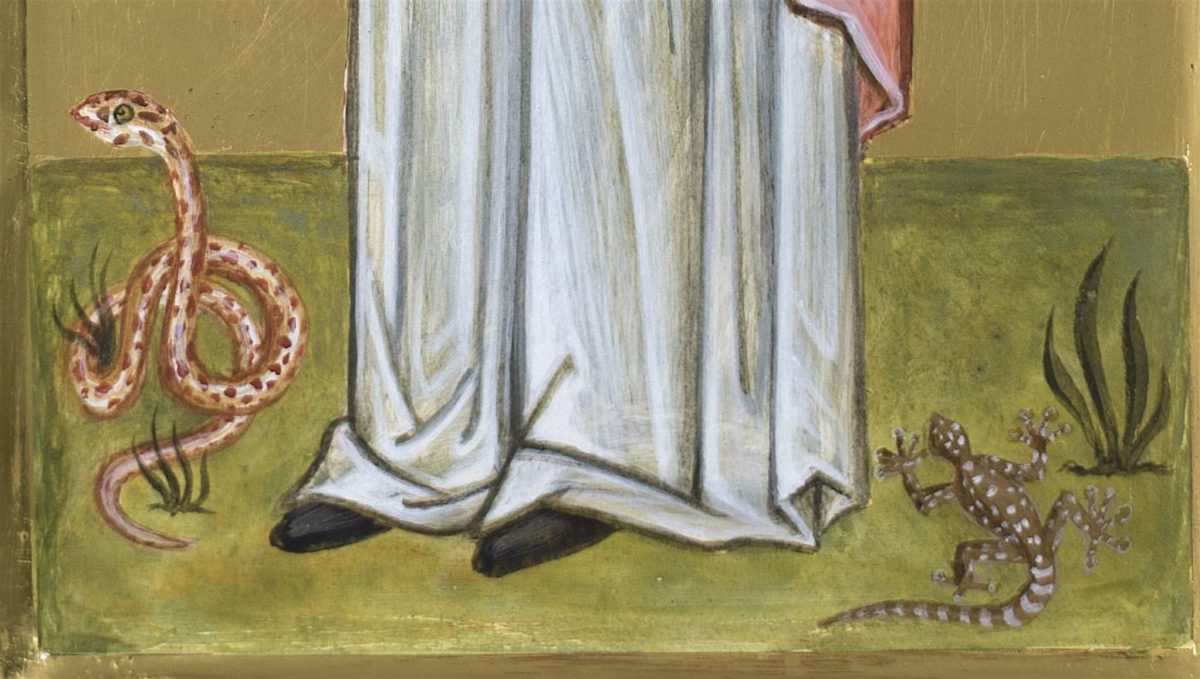
These creatures, and Saints Irenaeus and Isaac, face up or move towards Christ, acknowledging Him equally their Creator and Sustainer. By looking out at us, the canis familiaris draws us into the upshot, as though inviting us to partake of this liberation. This attitude of praise and thanksgiving lies at the centre of Edenic life, just as ingratitude lies at the heart of a hellish life.
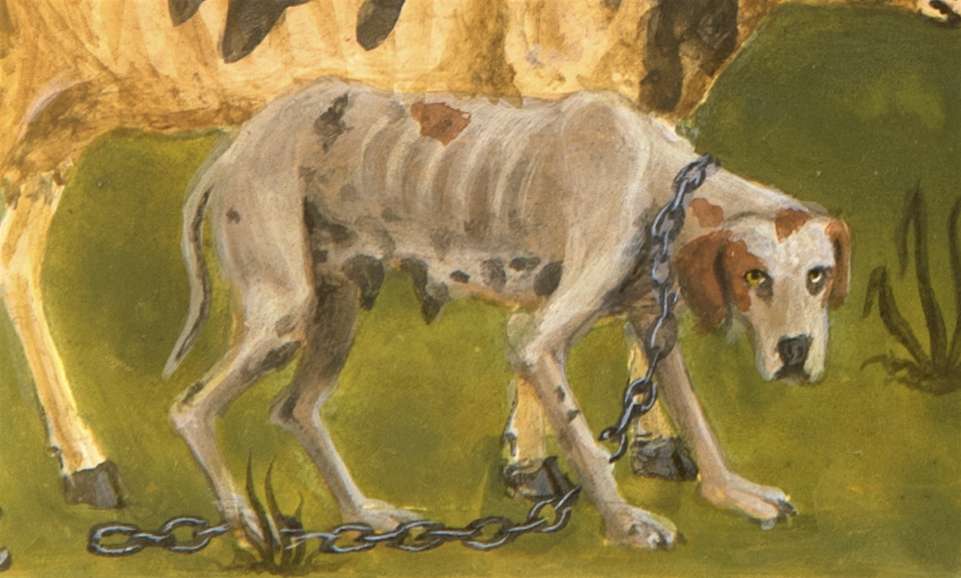
Sometimes the Bible describes a blunder that proves to be a prophecy. Such is the case when Mary Magdalene mistook the risen Christ for a gardener.
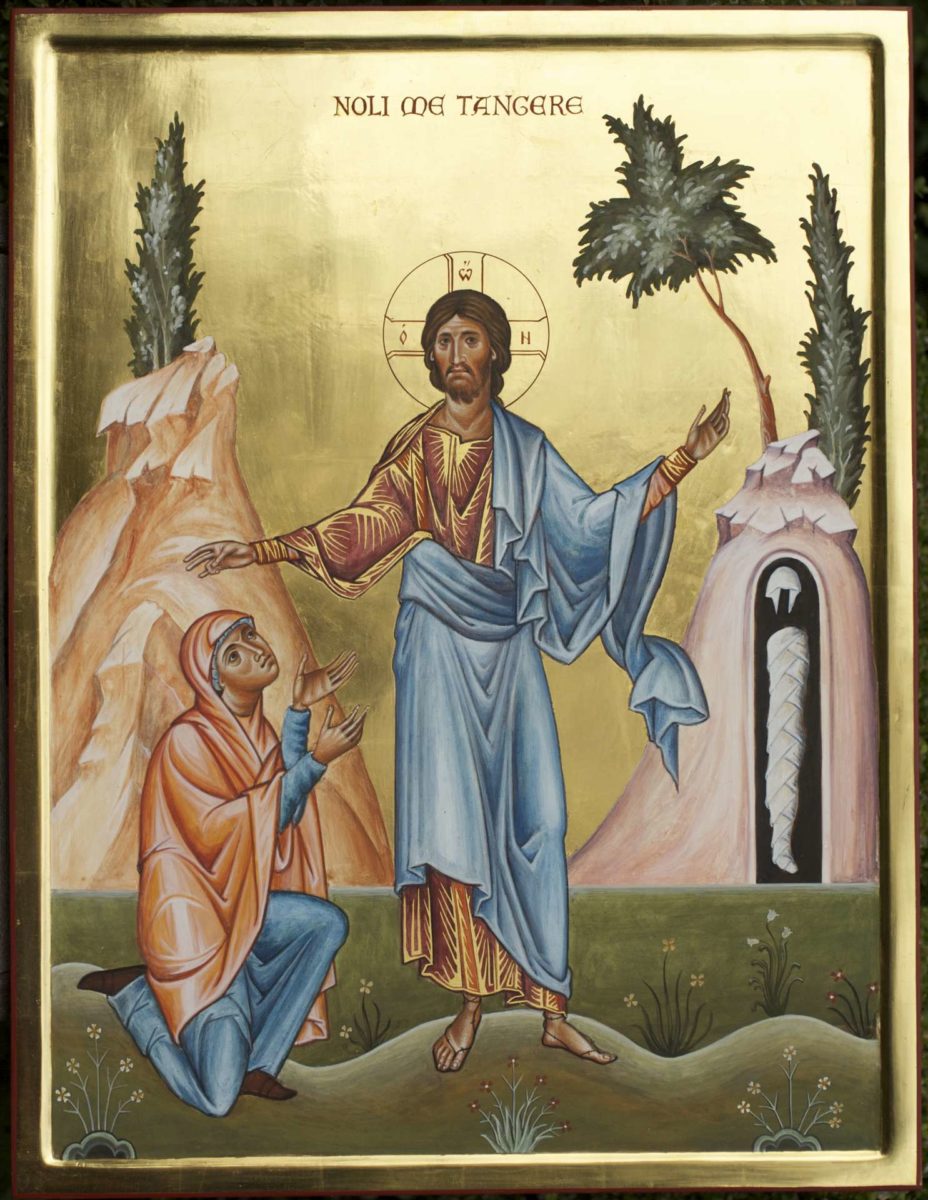
He is in fact the archetypal gardener, the 2d Adam who nurtures creation, tilling and keeping it with love and reverence in a fashion that the first Adam failed to practise. This triptych shows Christ in the midst of cosmos, like a second Adam in paradise. He blesses with information technology His correct paw, and directs information technology with His left. He is the prophet, priest and king of creation.
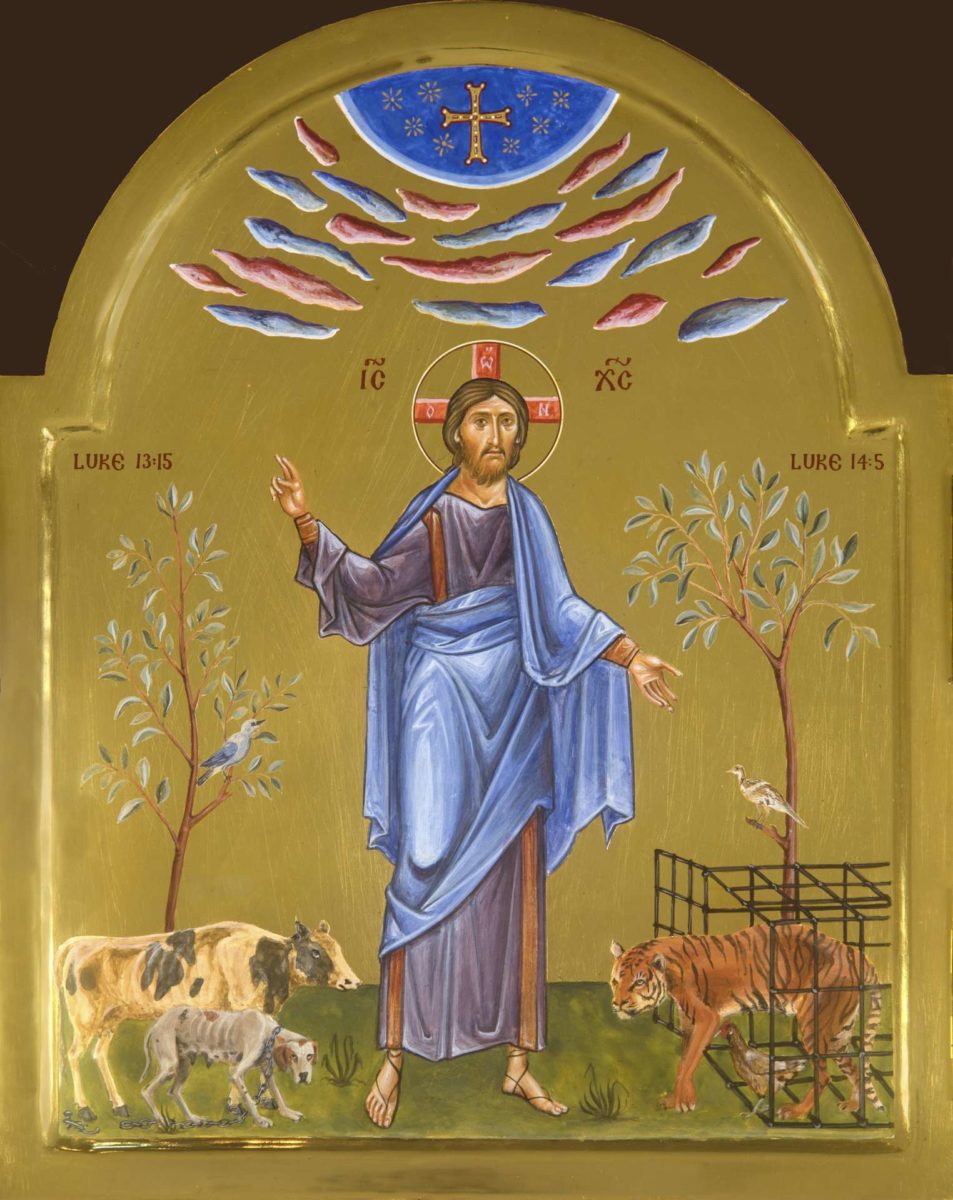
What of the predicament of our electric current age? The icon depicts the tiger, cow and dog every bit emaciated, victims of human fail. But it also shows Christ blessing and liberating them, the tiger and craven from their cages and the dog from its chains. Christ has come to gear up not just humanity gratis, but all creation.
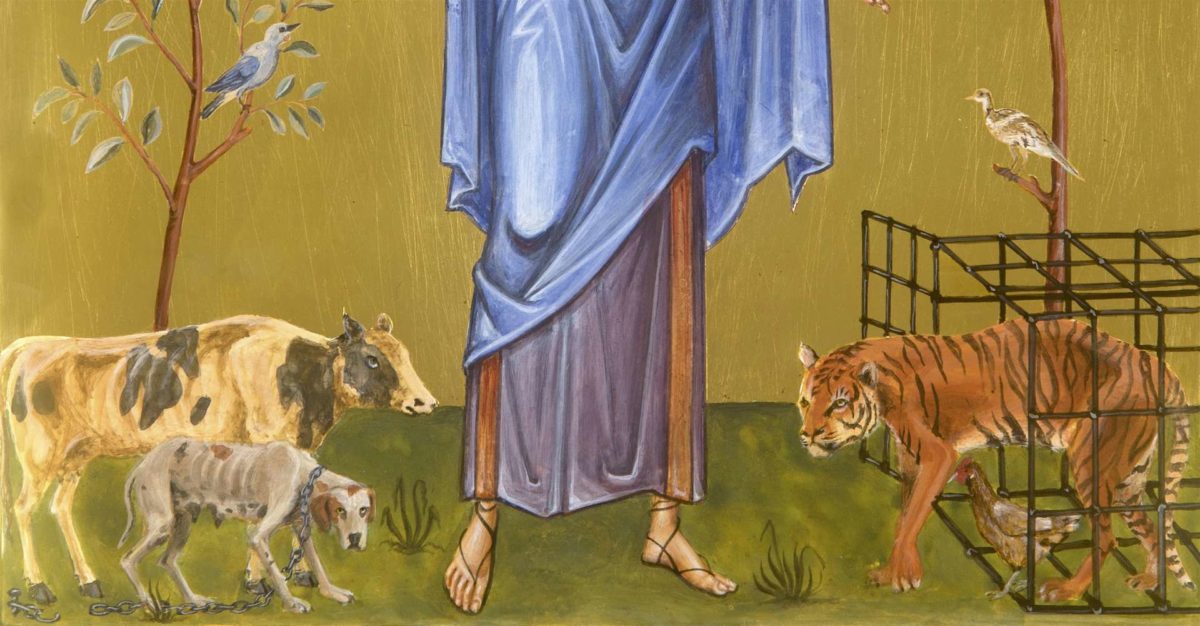
The quote on Saint Isaac the Syrian'southward scroll suggests that oppression of animals is the result of lack of pity, lack of virtue: "Oppression is eradicated past compassion and renunciation." The compassion that makes us feel for our fellow humans is the same virtue that impels us to sympathize with the suffering of a swain animal. Although nosotros humans are more than just animals, we are at to the lowest degree animals. In our physicality we are related to the animal kingdom. To mistreat them is by extension to mistreat ourselves.
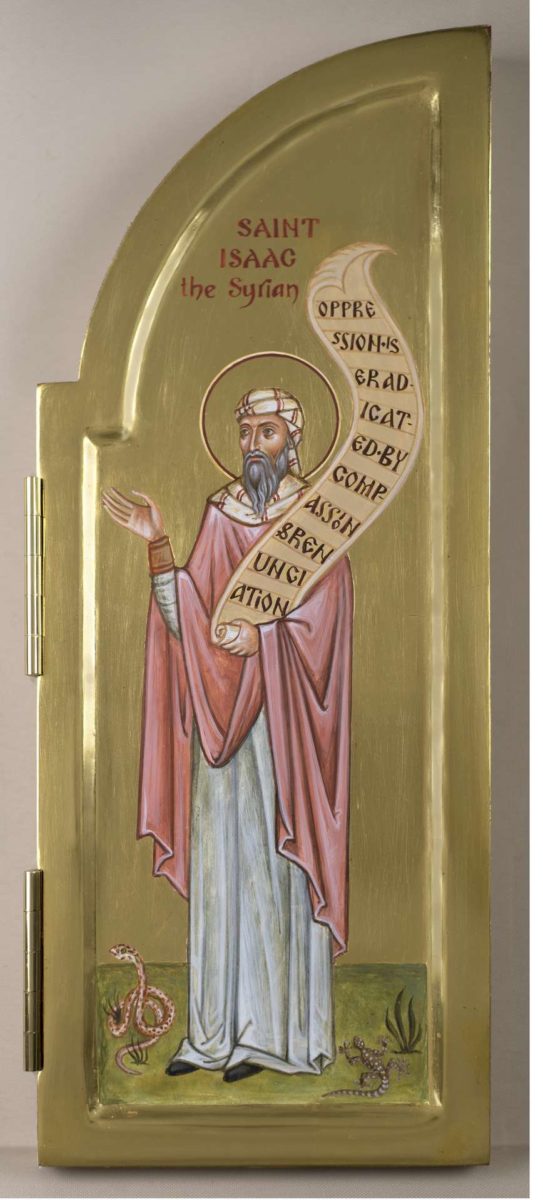
All this is not to say that the icon is promoting vegetarianism. But it is asserting that cruelty to animals is contrary to God's intention; that we are to care for them and respect them, even when our survival requires killing them for food. I was very impressed past a documentary I once saw that followed the life of some traditional African San bush people. The men were hunting a gazelle, the main source of food for their tribe. They had but spears, and so the merely way to kill it was to chase it on foot for many miles, until at last information technology had to stop and surrender, exhausted. Before killing it, the ane hunter who had managed to endure the marathon upwardly to this bespeak spent fourth dimension to give thank you to the animal for offering itself. There had been a struggle of equal strength, and this fourth dimension the hunters had won. Other times they would lose. The bushman thus believed that he was not taking the gazelle'south life but receiving it. The gazelle was offering itself for the sake of his life and his family unit'south life.
Intendance for animals in our charge is a theme of the Gospel passages whose references are inscribed in the central panel:
So the Lord answered him, "You hypocrites! Does non each of you lot on the sabbath untie his ox or his donkey from the manger, and lead it away to water information technology?"
(Luke 13:15)
And he said to them, "Which of yous, having a son or an ox that has fallen into a well, volition not immediately pull him out on a sabbath 24-hour interval?"
(Luke 14:5. Annotation: Other ancient government readan ass instead of a son)
Saint Irenaeus' quote on the left wing continues this theme of Christian love and kindness towards all God's cosmos: "Now, amidst the 'all things' our world must be embraced." By itself this text is somewhat opaque. It makes more sense in its context, even in the somewhat blowsy 19th century translation constitute in the Ante-Nicene Fathers series:
…as John, the disciple of the Lord, declares regarding Him: 'All things were made past Him, and without Him was nada made' [John 1;3]. At present, among the 'all things' our earth must exist embraced. It too, therefore, was fabricated by His Discussion, as Scripture tells united states in the volume of Genesis that He made all things connected with our world by His Discussion.
(Confronting Heresies, Book 2, II:5,6) [1]
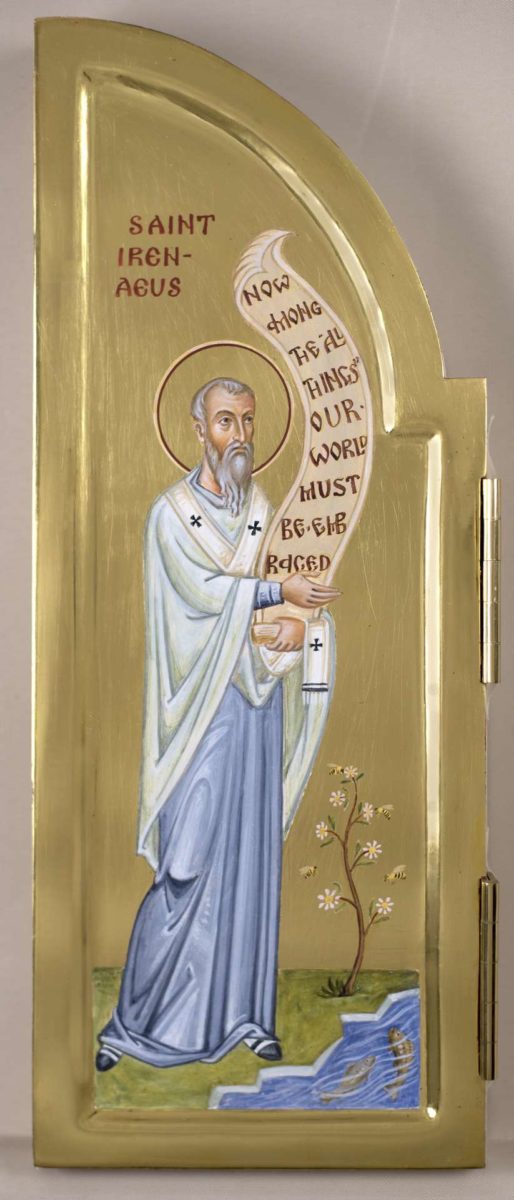
St Irenaeus is telling us that all things are made by God, from stone to brute to angel, and equally such are to exist honoured. He was countering a Gnostic heresy current in his fourth dimension, which asserted that the material world was not created by God but past a demi-god, and that it entrapped the soul. Irenaeus refutes this by showing from the Scriptures that the universe is created by God, and is a means of union and communion with Him and not an impediment. Although information technology would be difficult today to discover many people who adhered to Gnosticism in this raw sense, surely a Christian is not far from this heresy when he or she lives every bit though the brute kingdom were of no consequence to their spiritual life, apart from being a source of food.
I chemical element of Christ's Nativity that the Church's liturgical texts emphasize is that the incarnation inspires all creation to offer Him thanks. The Incarnation initiates the outset of a new creation. In this renewed paradisical life creatures receive life with thanksgiving, instead of grabbing information technology and turning from God as did Adam and Eve. Each affair and being offers thanks according to its nature. Every bit a hymn of Vespers so beautifully puts information technology:
What shall nosotros offering you, O Christ, because you lot accept appeared on earth as a man for our sakes? For each of the creatures made by you offers you its thank you: the Angels their hymn; the heavens the Star; the Shepherds their wonder; the Magi their gifts; the earth the Cave; the desert the Manger; but we a Virgin Mother. God earlier the ages, have mercy on united states.
(Great Vespers of Christmas. Translation by Archimandrite Ephraim Lash)
In the icon not only do the Edenic creatures face Christ, but also the liberated cow, dog, chicken and tiger. Christ frees them not but from physical oppression, just besides so that they can reach their fullness as participants in the cosmic liturgy of praise.
Just equally a sunflower turns its head throughout the day to follow the sun, and then all creatures are created to live in adoration of their Creator, each co-ordinate to their nature. Cruelty to animals therefore not simply causes physical suffering to the victims just also introduces a tragic noise to this catholic hymn. Such behaviour is a sin not only against the animals, but is too a failure of us humans to be conductors of the eucharistic choir.
When nosotros separate our treatment of animals from our worship we are like the priest and the Levite in the parable of the good Samaritan (Luke 10:25-37). When they saw the homo beaten up by robbers, in their haste to worship in the temple they crossed to the other side of the road to avoid caring for him. I wonder if God accepted their worship when they reached the temple?
The last three Psalms of the Bible, collectively chosen the Praises or Lauds, are sung at the terminate of every Matins service. They are the culmination of all that has gone before and, together with the Doxology "Glory to God in the highest", are the precursor to the Holy Liturgy or Eucharist that follows:
1 Praise the Lord!
Praise the Lord from the heavens,
praise him in the heights!…
7 Praise the Lord from the globe,
you sea monsters and all deeps,
8 fire and hail, snow and frost,
stormy air current fulfilling his control!
9 Mountains and all hills,
fruit trees and all cedars!
10 Beasts and all cattle,
creeping things and flying birds!
11 Kings of the world and all peoples,
princes and all rulers of the world!
12 Immature men and maidens together,
sometime men and children! …..
(Psalm 148:i, 7-12)
This is not only a call for u.s.a. humans to praise God, simply also all creatures, and fifty-fifty the inanimate kingdom. Our destiny and calling is inexplicably tied up with all creation.
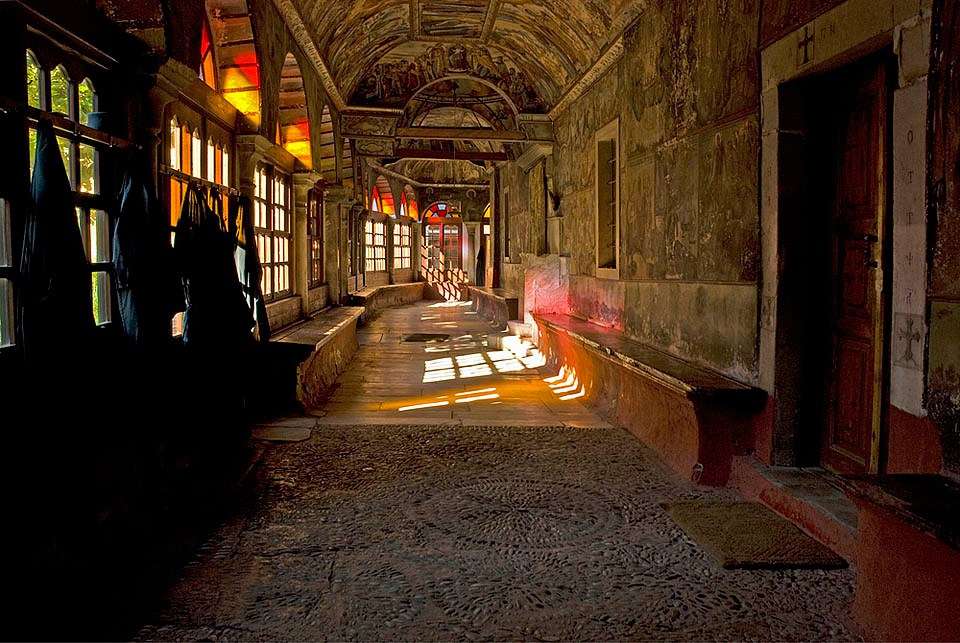
Christ's Second Coming and the New Jerusalem
Nosotros accept discussed how our triptych hints at Paradise and Christ's incarnation and resurrection. What of His 2nd Coming and the New Jerusalem?
Roman mosaics offered a solution when I was looking for ideas. Rome is dwelling to numerous apse mosaics dating from the first millennium. Some of them evidence Christ in the midst of brightly coloured clouds. Examples are found in the churches of Santa Cecilia in Trastevere, Santi Cosma e Damiano, Santa Constanza, Santa Prassede, and Santa Maria Trastevere.
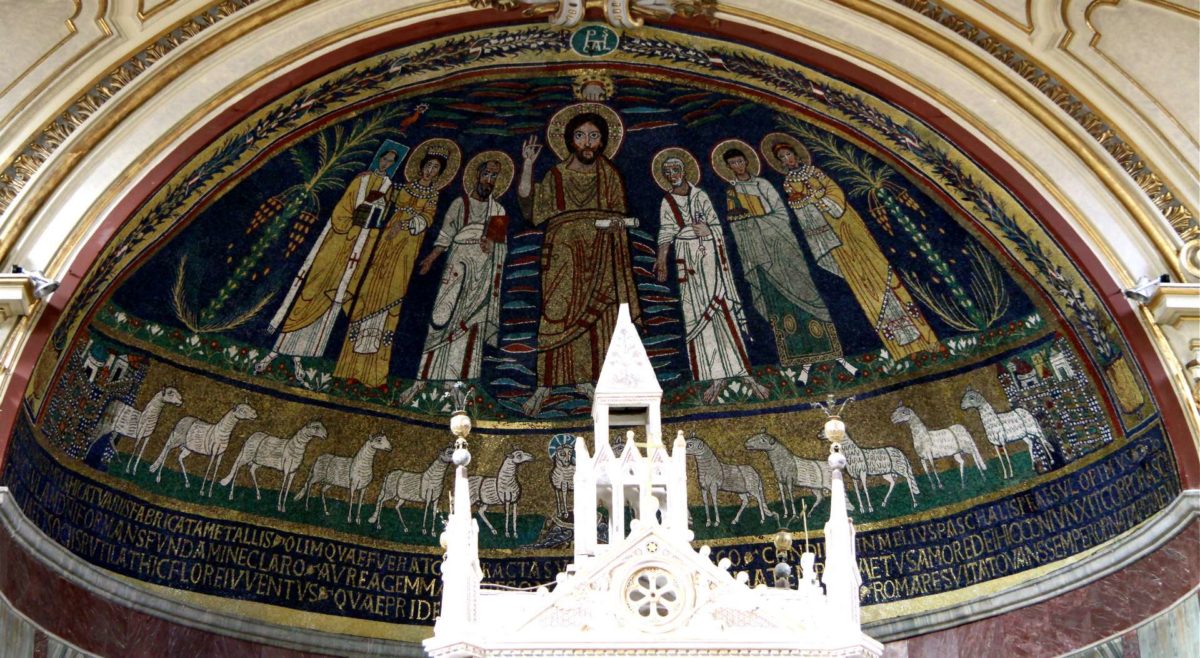
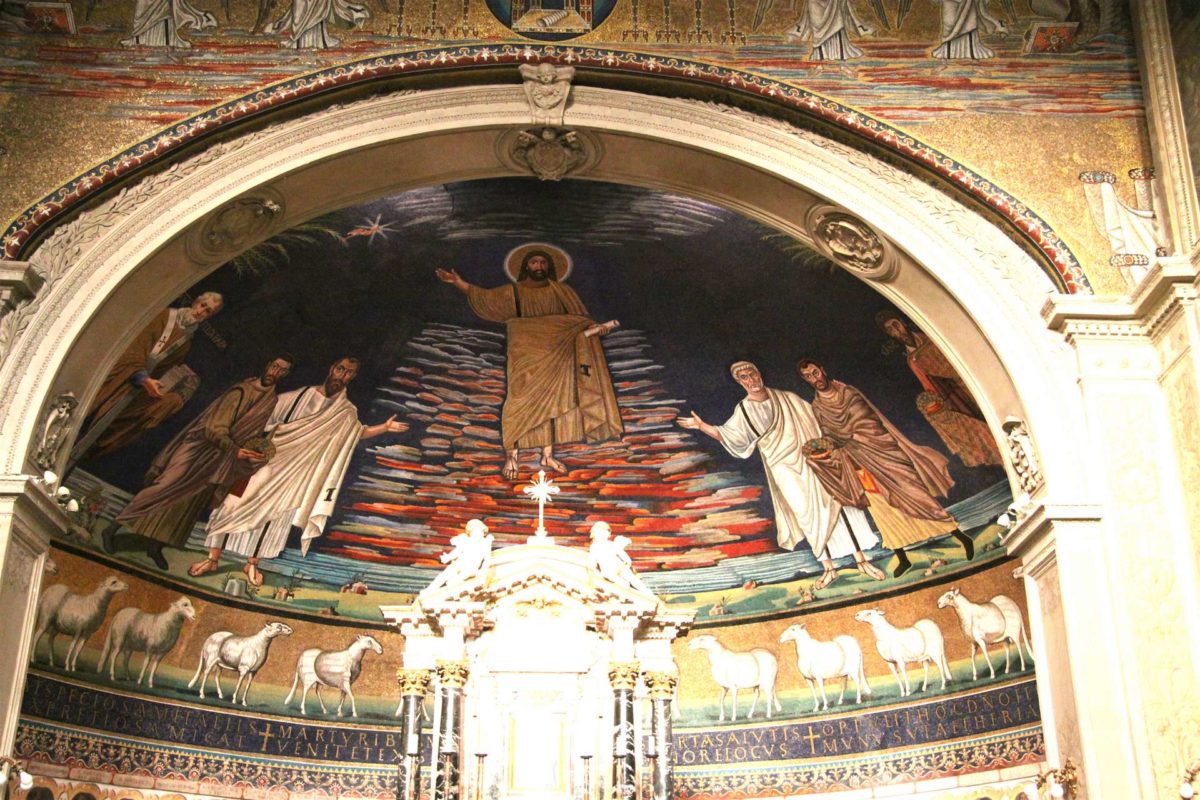
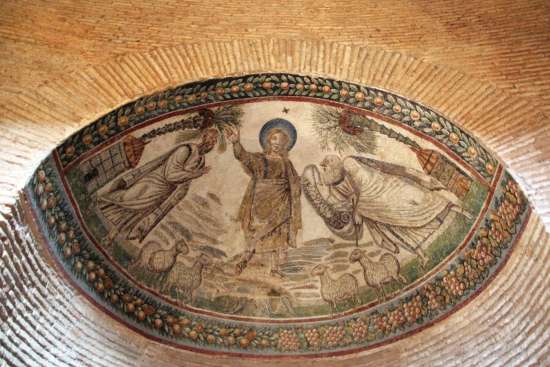
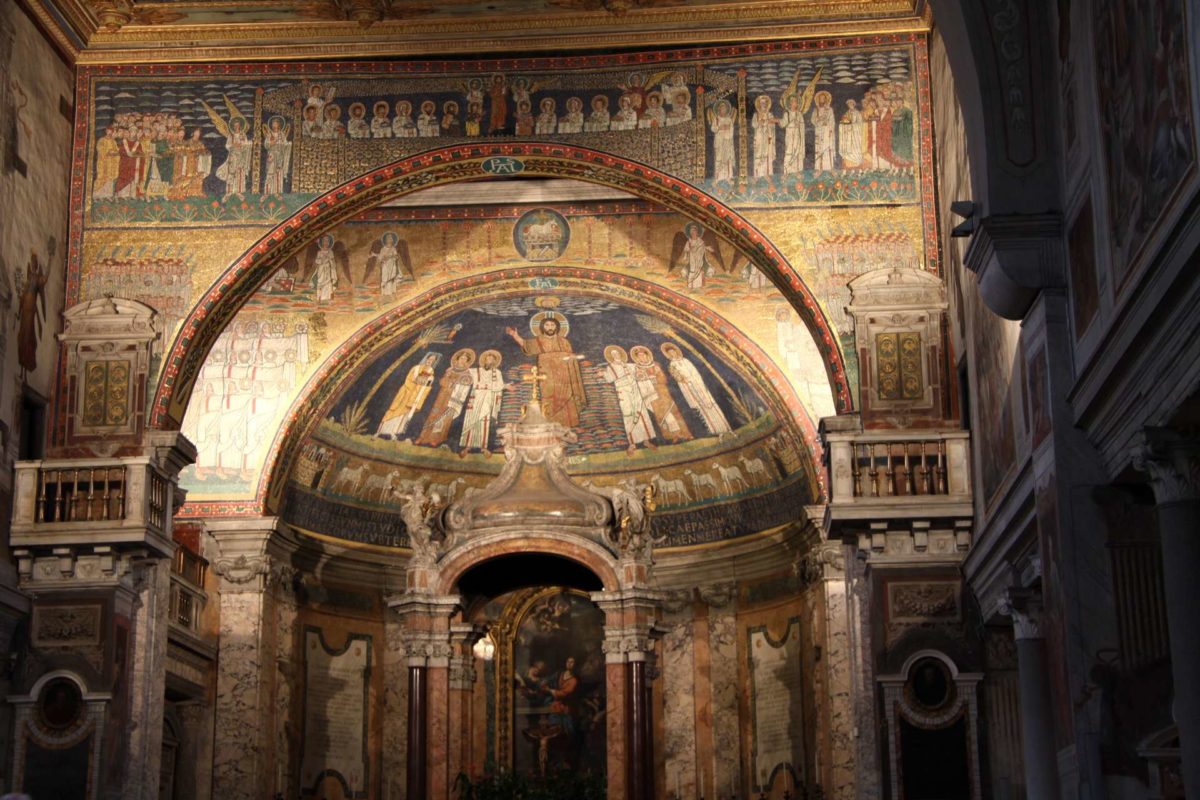
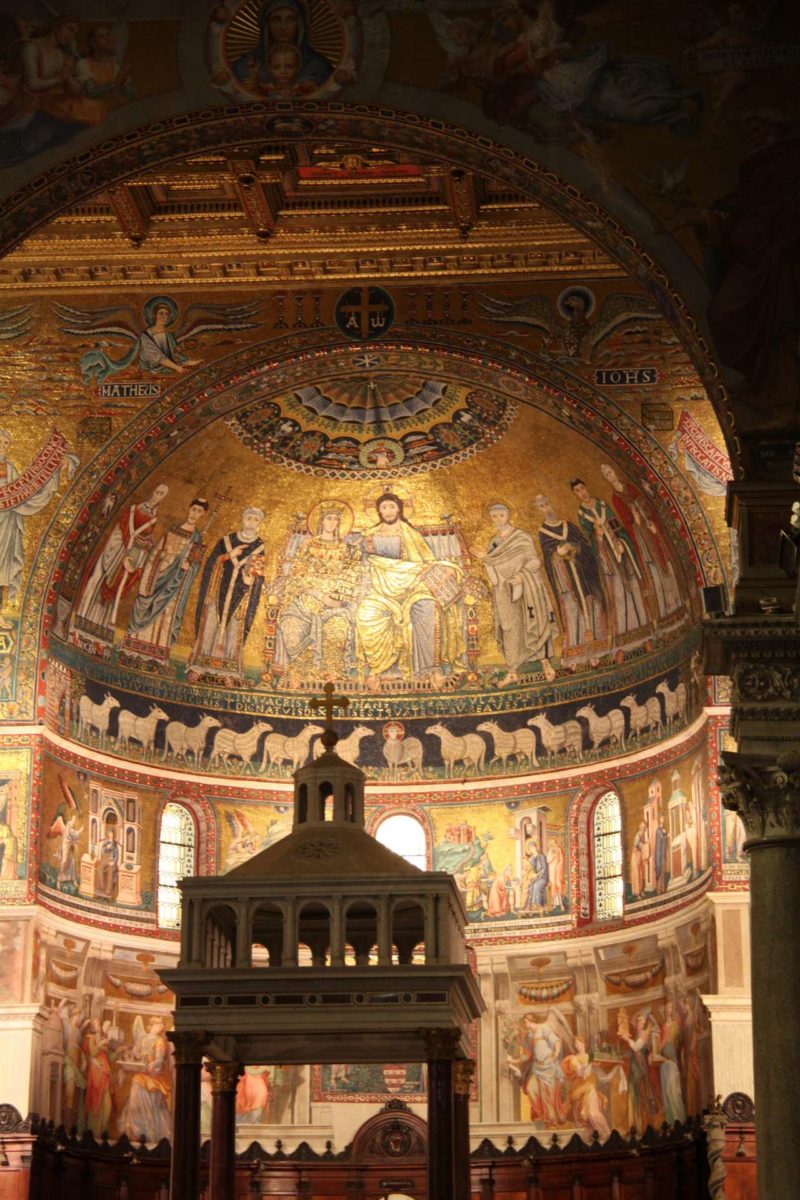
What do these clouds stand for? They are clouds of a sunrise, and thus betoken Christ'due south 2nd Coming in glory:
…then volition announced the sign of the Son of human in heaven, and and then all the tribes of the earth will mourn, and they will encounter the Son of man coming on the clouds of heaven with power and bully glory… (Matthew 24:thirty)
About of these apses also bear a cross at the apex. This is the "sign of the Son of Man" that will appear in the skies at Christ'southward coming, a sign traditionally understood by the Orthodox Church to be the cantankerous. The stars that environs our cross in the triptych correspond the host of heavenly angels that will back-trail Him.
Why should we include the theme of the future New Jerusalem in an icon about animals? Churches traditionally face east, towards the rise sun, towards Christ's coming over again in glory. Consciously or unconsciously, every individual and every culture lives the present in the light of their belief about the future. When driving a machine, nosotros tend to steer in the direction nosotros are looking. Our actions tend to follow our gaze, follow our vision of the platonic.
John's description of the New Jerusalem is highly symbolic, and is not intended to provide lots of item to exist taken literally. But the essence of what he is saying is that God will be pleased to dwell among us, because all His creatures volition be living in harmony with one another. At that place will exist no sin or cruelty, and therefore no death, crying or hurting.
Nosotros exercise non know for certain what identify animals will have in this customs of the New Jerusalem, simply if we are to take at face value Isaiah'southward words quoted at the offset of this article, at that place will be lots of them and nosotros volition all live in unity. If the destiny of homo and beast is not to "hurt or destroy in all God'due south holy mountain", why not begin to live like this now, inasmuch every bit information technology is possible? Hopefully this niggling icon will help a few of us to begin.
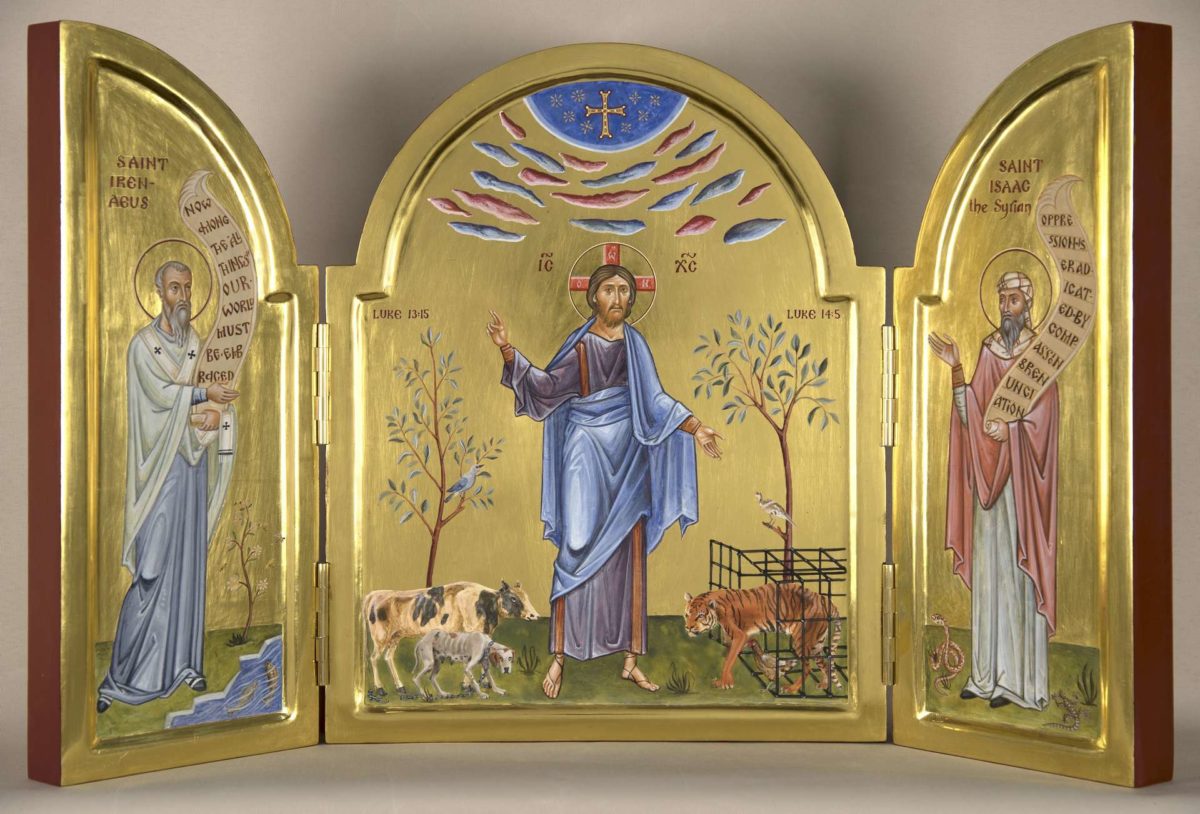
[i] (Against Heresies, Book two, II:5,half dozen, translation in "Against Heresies, by Irenaeus, ed. Philip Schaff, Eerdmans, 1885. Page 85 in Woodstock, Ontario, 2017 edition.
Source: https://orthodoxartsjournal.org/the-making-of-a-new-icon-christ-breaking-the-bonds-of-animal-suffering/
Posted by: craftratepand.blogspot.com

0 Response to "Which Animal Was An Iconographic Symbol Of Eternal Life In Heaven?"
Post a Comment